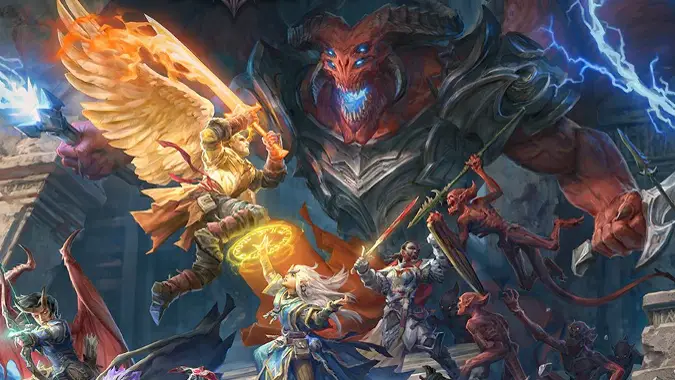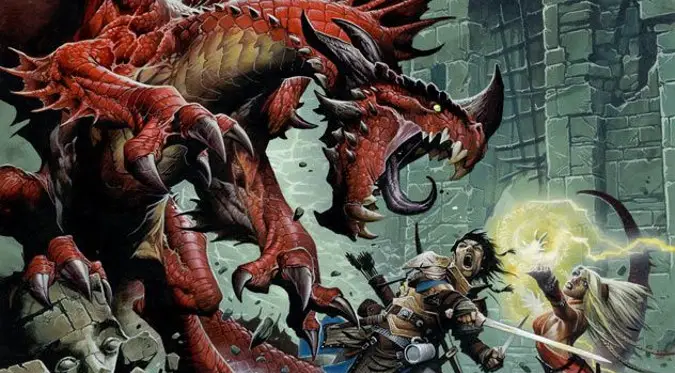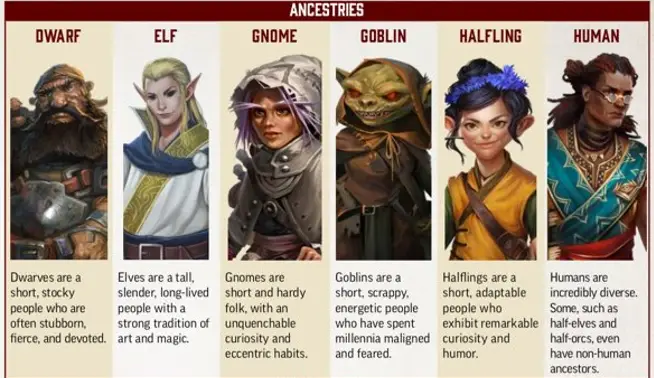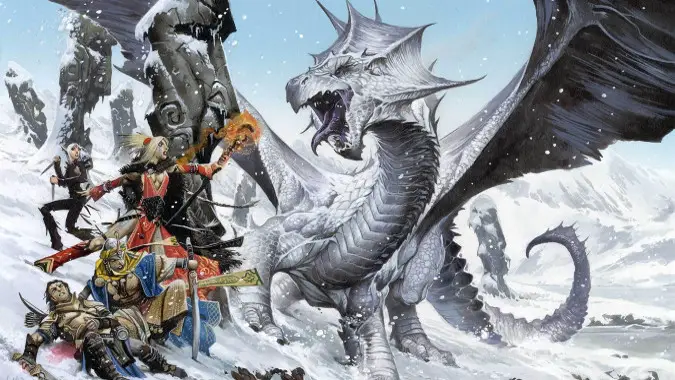How to start playing the Pathfinder 2nd edition TTRPG

Learning how to play Pathfinder 2nd edition is relatively easy for people who play tabletop RPGs, especially Dungeons and Dragons 5th edition. It would not be unfair to say that PF2 is essentially D&D’s cousin, because both games trace their origins back to the original AD&D. When the first edition of Pathfinder came out in 2009, it was essentially an improved version of D&D 3.5e. With D&D 4e, the two games started diverging, and today’s D&D 5e and Pathfinder 2e are different games, despite their shared ancestry.
Unlike other TTRPGs such as Call of Cthulhu or Apocalypse World or Champions — which may be a bit harder for D&D players to pick up — both Pathfinder and D&D are fantasy-themed, d20-based systems, and many of the game’s core features are similar. Pathfinder’s classes and ancestries (similar to races in D&D) will be familiar to D&D players, and it even has the exact same ability stats — Strength, Dexterity, Constitution, Intelligence, Wisdom, and Charisma. To perform actions in Pathfinder, you’ll roll a d20 and add or subtract modifiers to determine success. just like D&D. The basic game concepts like hit points, armor class, and saving throws are all in Pathfinder, though sometimes they’re expressed slightly differently.
And now is a great time to start playing Pathfinder, because Wizards of the Coast’s mishandling of D&D 5e and the Open Gaming License, which would have limited what community creators could do with the game, means a lot of players are looking into new TTRPG options. Paizo took a very public stand against attempts to lock down D&D with draconian licensing agreements, including saying they’d take WotC to court, which brought a lot of attention to Pathfinder 2e. So why not take a look at this easy-to-learn game?
Here’s what you need to know to start playing Pathfinder 2e.

What you need to play Pathfinder
You don’t need much to get started with Pathfinder, because you can find basic rules and character creation resources online for free. But if you find you enjoy the game, you may want invest in digital or physical books, and GMs will probably want to grab the Bestiary and some Adventure Paths. (In good news for GMs, there is no separate book for players and gamemasters, so you don’t need to make a huge extra investment.)
If you already play D&D, chances are you already have any basics you need: the game will use the exact same array of dice, and if you play in person, minis and map grids work equally well for either game. Here’s everything else you’ll need to start playing Pathfinder 2e.
Get started with free digital resources
Because Pathfinder is released under the Open Gaming License, you can find a basic version of Pathfinder rules online, indexed and searchable via the Archives of Nethys. While this isn’t a complete replacement for physical (or digital) books, it’s an extremely handy fast reference tool for new players and GMs. Yuo can also read the Pathfinder primer on the Pathfinder Nexus site (login required).
Paizo has plenty of free resources, too: you can download pre-generated characters, blank character sheets, a demo adventure, and a lot more. In short, you can familiarize yourself with the game and start playing without spending a dime.
Where to buy Pathfinder books, adventures, and more
If you enjoy playing and want to delve deeper into the game, you can buy books online from Paizo or at your local game shop which I encourage you to check out — though printed Pathfinder books have been in short supply lately. Unlike some other companies, Paizo has pretty much every product they offer available as a PDF file, which can make it easier for everyone at the table to have their own copy of the rules. While the Pathfinder 2nd edition hardcover is one of the best rulebooks I’ve ever seen from a graphic design standpoint, having instant access to a PDF can be useful.
If you’re planning on running PF2 for a group, you’ll want things for them to be menaced by: the Pathfinder Bestiary is full of monsters for the system. But you’ll probably also want some adventures to run, and Paizo’s excellent Adventure Paths are one of the best things about the game. These are essentially the same as D&D mega adventures like Baldur’s Gate: Descent into Avernus, planning out a complete campaign with all of the details a GM will need to run a successful game. Paizo releases new Adventure Paths monthly, and they cover the range of adventures from starting 1st level to high level or even mythic difficulty.
You can certainly run your own adventures, of course, but it never hurts to read through other ideas and get inspiration.
Digital tools for playing Pathfinder
Pathfinder doesn’t have a digital toolset that’s quite as robust as D&D’s, but the game is getting there. If you buy digital books, you’ll also unlock them on Pathfinder Nexus, the official digital toolset for Pathfinder. It will let you read and search all of the books you own — as well as the free basic rules — and it has a character builder in development (currently in closed alpha). If you want a character builder right now, you can use Pathbuilder 2e, which might well be the best RPG character creator out there, bar none.
You can also play Pathfinder on major virtual tabletop systems, including Roll20 and Fantasy Grounds. Expect digital books for and maps for these VTTs to cost about the same as they cost for D&D.

Differences between Pathfinder and D&D
Pathfinder is a relatively high magic, high fantasy role playing game. It’s set in the world of Golarion, which is similar to settings you’ll find in D&D, like the Forgotten Realms. The game can do anything its cousin does, but offers a host of additional options, letting players to make more decisions and offering more variety in gameplay and character creation.
But that can also make it more complicated — and more difficult to pick up. For example, in D&D, on your turn you can perform a strict set of activities: a movement, an action, and a bonus action. In Pathfinder, on your turn you can perform three actions of your choice. That opens up your options, but requires you to be more familiar with the actions you can do, and how you can combine them to best effect.
The skill system in Pathfinder is more complicated, too. Skills have different levels of ability called Proficiency Ranks, ranging from Untrained all the way up to Legendary. A Legendary Proficiency in a skill means that you can do wonders, like talk the birds into lending you their songs to shackle a monster wolf, walk down a single strand of hair to escape a burning palace, all that kind of thing. Again, it gives you more options — some of them wildly powerful — but requires you to know what you’re doing to build your character and take advantage of these features.
Character creation also has more depth. Pathfinder has abandoned the idea of races: instead, the game uses Ancestry to determine the type of character you play. This offers you more flexibility and options, so you could play a character of Human Ancestry and take the Half-Elf or Half-Orc option. You could pick any Ancestry and do the same thing, customizing your character instead of having races for Half-Elf, Half-Dwarf, etc. It also embraces Feats much more broadly to give you more customization. Pathfinder deliberately eschews some of 5e’s simplicity in order to give players and gamemasters more choices.
For an in-depth look at how the game uses Classes, Feats, and Archetypes to help create exactly the character you want to play, we have a review from the game’s release that will help you get a sense of it all.
Pathfinder can be more complicated than D&D, and it may take you time to get used to the way the game works. But if you play D&D, you’ll already know the basics, and you may enjoy all of the extra options Pathfinder gives you.

Why you should be playing Pathfinder
At its core, you can do everything with Pathfinder you’d do with D&D. You can run published adventures in the base setting of the game, you can create your own world with completely original adventures, or a mix of both. But Pathfinder is a flexible TTRPG that puts a lot more customization in your hands from the get-go, whether you’re a player or a GM. Think of it as D&D but more, giving you extra options and customization at every level of gameplay.
Also, it would be remiss to forget to mention Starfinder, another Paizo TTRPG in a sci-fi setting — it’s essentially Pathfinder in space. It’s even still set in Pathfinder’s world Golarion, though it’s thousands of years in the future. More importantly, you can run Starfinder characters and monsters with minimal adaptation, meaning that your Pathfinder 2e campaign could use not only the already vast library of Pathfinder products, but also the wide Starfinder library as well.
If you’re a D&D player looking for new challenges, it’s well worth giving Pathfinder a try. With all of the free resources available, it’s easy to check out the game, and get playing immediately.
Originally published July 20, 2020; updated March 31, 2023
Please consider supporting our Patreon!
Join the Discussion
Blizzard Watch is a safe space for all readers. By leaving comments on this site you agree to follow our commenting and community guidelines.
 @MatthewWRossi
@MatthewWRossi



